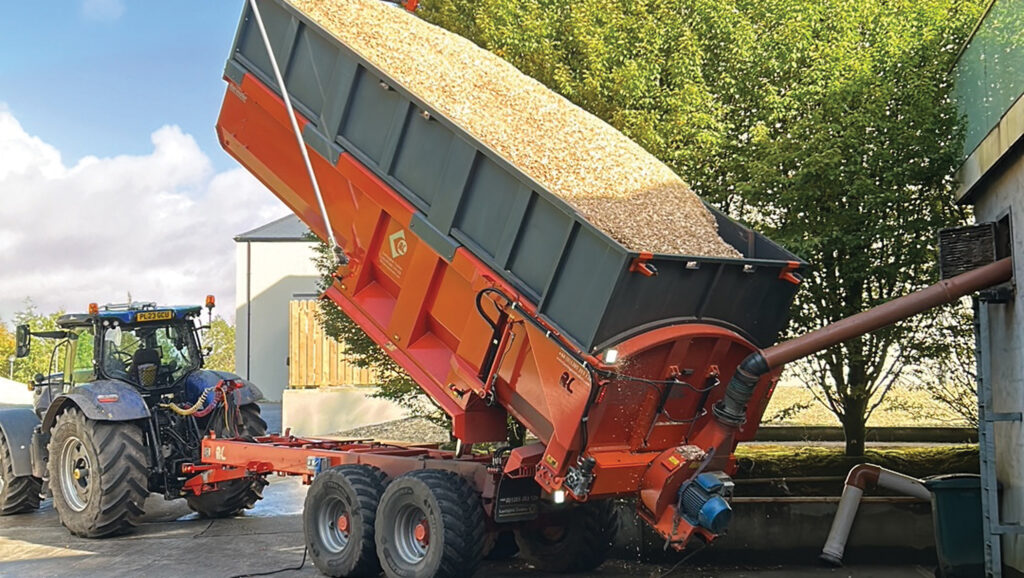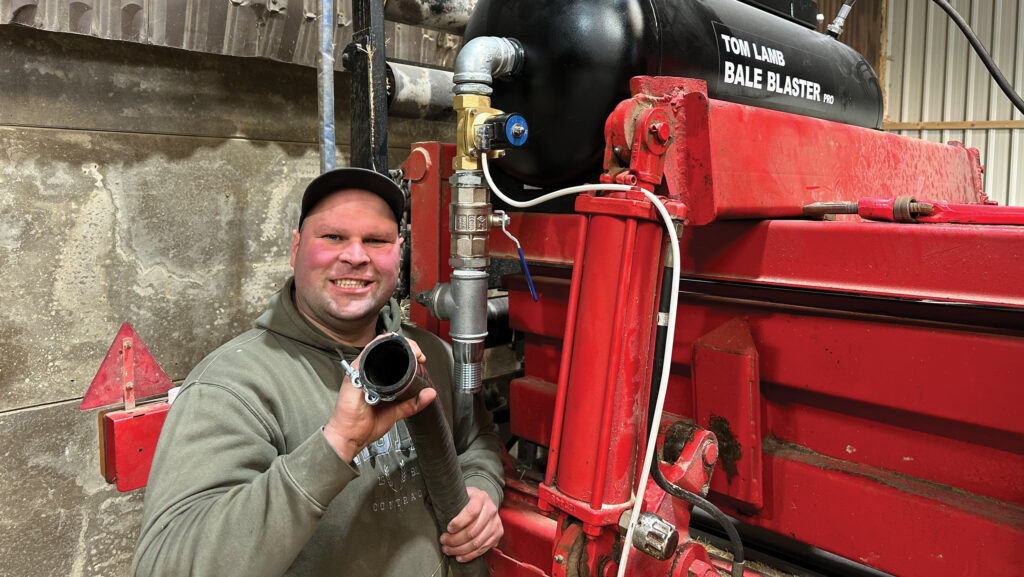FW Inventions Comp opens for entries with £2.5k prize pot
 Gavin Winters’ woodchip blower trailer © Gavin Winters
Gavin Winters’ woodchip blower trailer © Gavin Winters It’s time for another season of Farmers Weekly’s long-running Farm Inventions Competition.
With a back catalogue containing thousands of ingenious ideas, there’s nowhere better to read about workshop builds that have saved time, hassle or cold, hard cash.
See also: Bedfordshire farmer builds 6m low-disturbance drill for wet ground
And if you have designed a machine or gadget of your own, it’s time to get involved.
The competition’s format means you can still win one of the top prizes, even if your creation or modification is small and relatively uncomplicated, as each entry is judged against four criteria – inventiveness, originality, safety and usefulness to others.
The total pot for this year is £2,550, with the results decided by a panel of journalists and farmers.
How the competition works
The entries are split into three categories:
- Simple Items that took a day or so to knock together and are fairly basic in the way they work, but still save time or money
- Intermediate Anything more sophisticated, perhaps with a simple form of hydraulic or electrical system
- Complex Machines that have taken months or years to design and build. They usually involve an engine or a complicated combination of electrics and hydraulics.
Who is eligible to enter?
The competition is open to farmers, contractors, farm managers and farmworkers.
What if I’ve entered my design in other local inventions competitions in the past?
You are still welcome to enter.
What are the prizes?
The winner of each of the three categories gets £500, runners-up will bag £250 and the third-placers get £100.
Will you feature the winners?
All nine prize-winning inventions will be featured, along with the best of the rest, in Farmers Weekly magazine and online. Many of the machines you see on the stands at shows such as Lamma started life in the farm workshop, so it’s a great opportunity to get your ideas in the shop window.
How do I enter?
Just send some details about how the machine works and what you use it for to oliver.mark@markallengroup.com. You will also need to include a couple of decent-quality pictures and a phone number so we can get in touch. The closing date for entries is 23 January 2026.
Who won last time?
Complex category: Gavin Winters’ woodchip blower trailer

The motor and auger at the rear of Gavin Winters’ trailer © Gavin Winters
Gavin Winters of County Tyrone-based Winters Renewables bagged the complex category crown with his high-spec blower trailer.
The driver for this ambitious project was a need for a more effective method of transporting dried woodchip and getting it quickly into stores.
Gavin had already tested the concept with an older, smaller trailer, but was keen to have more capacity and better reliability.
A large donor rig was required, which came in the form of a 14t Richard Larrington Harvest, snapped up at a local Euro Auctions sale for £20,000.
Once the original rollover cover had been removed, he constructed a set of extensions that increased capacity to 42cu m and set about modifying the tailgate to accommodate the blower assembly.
This involved cutting an opening and fabricating a housing for an auger that would wind material into the central point where the blower unit would be mounted.
He drew the designs for this in Autocad and got a local laser cutting firm to make the profiles before carefully welding it in place.
Auger setup
The heavy-duty auger was sourced from Rotospiral in County Carlow and positioned so that the bearings could be externally mounted for easier maintenance.
He also rigged up a hydraulic power supply with a motor driving though a 7:1 reduction gearbox.
Flow of woodchip is controlled by a hydraulic door and the speed of the auger can be adjusted to get the right amount feeding through.
The blower itself is built by Austrian firm Auer and was another second-hand auction purchase.
It was cheap as the motor had packed up, but he soon replaced this with a new 11kW unit.
Electrical power comes from a three-phase pto generator slotted into the chassis.
Significant modifications were required to make this fit and ensure the shafts were running straight, including boring holes through cross-members using a mag drill, and repositioning the air tank.
A local company called Custom Hoses NI piped up the hydraulics, adding a spool block to control the hydraulic door, auger speed and tipping ram.
Finishing touches included designing and making a new hydraulic rollover cover and building a large toolbox up the side of the trailer to house the blower tubes.
These are made from 8in sewer pipe with Bauer fittings bolted on the ends.
Total build cost, including the trailer, was about £25,000.
Intermediate category: Tom Lamb’s Bale Blaster Pro

Tom Lamb with his Bale Blaster Pro
Fed up with getting a face full of dust and chaff when fiddling under his baler, Rutland farmer, inventor and YouTuber Tom Lamb rigged up an air system that can disperse the debris while he sits safely in the tractor.
One flick of an in-cab switch opens the Bale Blaster Pro’s two half-inch solenoid valves to release all the on-board tank’s air – 240 litres held at 120psi – in less than a second.
It is fired through a series of custom jets that can be mounted anywhere on the baler where material is likely to accumulate, including under the rear axle.
As well as saving the operator from getting caked in grime, the system can be used to clean machines between fields to reduce the risk of weed seed transfer.
To that end, there’s also a retractable airline on the side so that operators can manually blow off hard-to-reach spots.
Once jettisoned, the tank is refilled via the tractor’s air supply.
Alternatively, older models can be rigged up with a hydraulically driven compressor, with the spool simply set to constant pump.
He also incorporated a manual tap in the plumbing so the jets can be isolated when they’re not required, and there’s an integrated fire extinguisher system to quell any embers in hot, dry conditions.
Simple category: John Hutcheson’s budget temperature probe

John Hutchison’s low-cost temperature probe © John Hutchison
Tired of waiting three or four minutes for his handheld grain probe to settle on a temperature value, Fife farmer John Hutcheson went in search of some permanent alternatives.
Off-the-shelf options existed but, at £42 a pop, they were too expensive to justify stationing at each of the farm’s measurement points.
John’s solution was to find out how they worked and make some himself.
Sifting through documents that came with the farm’s readout device revealed that the key component was a thermistor with a particular characteristic – essentially, the way resistance changes with temperature.
After carrying out a few tests on the handheld device, he worked out which type was required and ordered a batch online.
To make the probes, he soldered the thermistor onto one end of a length of wire and a 6.35mm audio jack onto the other, ready for the measurement device to plug into.
This assembly was then slotted into a length of 20mm electrical conduit, with regular cable glands and push-fit caps sealing off the ends to prevent grain getting inside.
The bits for one probe cost £5 and it took him 10 minutes to put together, making it easy to justify producing a large quantity.
With his portable unit, it often took the best part of a day to get around all of the farm’s stores, so having probes always at grain temperature has saved a huge amount of time.

